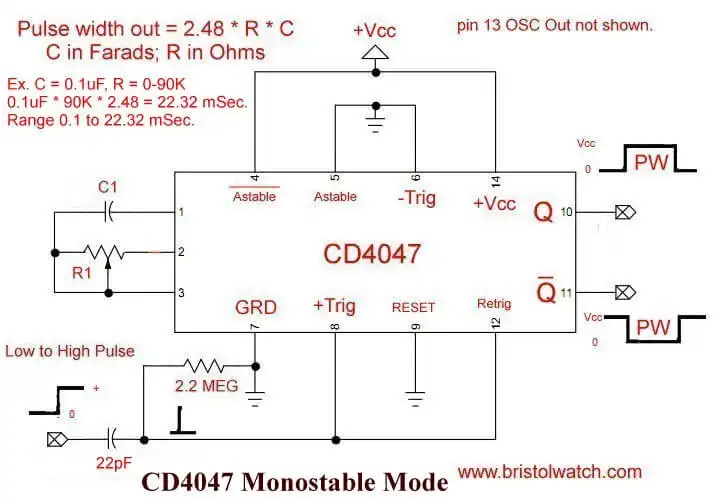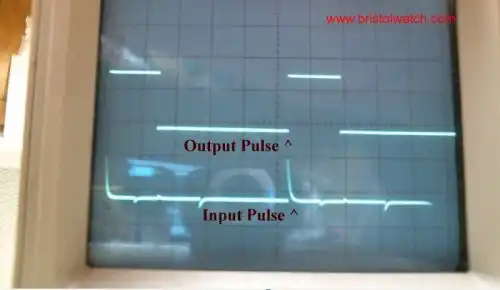
Fig. 1 CD4047 Monostable Mode Multivibrator circuit.
CD4047 Monostable Multivibrator Circuit
by Lewis Loflin
A Monostable Multivibrator is defined as:
Monostable Multivibrators or "One-Shot Multivibrators" as they are also called, are used to generate a single output pulse of a specified width, either "HIGH" or "LOW" when a suitable external trigger signal or pulse T is applied.
Another definition:
Monostable multivibrator, in which one of the states is stable, but the other state is unstable (transient). A trigger pulse causes the circuit to enter the unstable state. After entering the unstable state, the circuit will return to the stable state after a set time. Such a circuit is useful for creating a timing period of fixed duration in response to some external event. This circuit is also known as a one shot.
To simplify it's a circuit that when it receives an input pulse will produce an output waveform whose ON time is based on a capacitor-resistor combination then it will switch off.
These can be built with logic gates, transistors, or specialized integrated circuits. I'll explore some basic theory I'll focus on the CD4047 astable/monostable multivibrator.
The CD4047 is easy to configure for either mode, is low power, and has a voltage range of 3-15 volts, but works best at 5 volts. The circuit is strait forward just as shown.

Fig. 2 CD4047 Monostable Mode Multivibrator Waveform.
Fig. 2 illustrates the output from the CD4027 in the monostable mode. The input is a square wave but the differentiator formed by a 22pF capacitor created a positive going 'spike" that triggers a HIGH output whose ON time depends on the values of C1 and R1. The formula is Q = 2.48 * R1 * C1. In the example above Qon = 2.48 * 0.0000001 * 90,000 = 22.34 mSec.
Changing C1 to 2200pF and R1 to 10,000, Qon = 2.48 * 0.0000000022 * 10,000 =~ 55uSec.
A monostable can be useful for signal conditioning or time delay circuits. My test using polarized capacitors shows polarity doesn't matter.
- Why we should not fear nuclear power.
- Nuclear Graveyards Abound with Life
- What About Humans and Nuclear Radiation?
- Radiation Basics They Should Teach in High School
- Astable CD4047 High Voltage Power Supply
- Geiger Counter and Radioactivity
- Introduction to Geiger-Mueller Counters and Electronics
- CD4047 Monostable Multivibrator Circuit
- Getting Real About Radiation Myths and Hazards
- Uranium Hype-Facts and Virginia Uranium
- Uranium Basics and Isotopes
- Climate Change and Volcanoes
- Geiger Counter Adventures in Radioactivity Literature
- Using TL431A Li-Ion Battery Charger Tutorials
- TL431A Lithium-Ion Cell Charging Circuits
- Charging Multi-Cell Lithium-Ion Battery Packs
- TL431 Over-Voltage, Under-Voltage Detector Circuits
- TL431A Constant Current Source Working Circuits Demo
- Arduino Measures Current from Constant Current Source
- Constant Current Source Theory Testing
- Arduino Controlled Power Constant Current Source
- LM317 Adjustable Current Boost Power Supply
- Constant Current Circuits LM334, LM317
- Build LM317 0-34 Volt Power Supply
- LM334 Constant Current Source with Resistive Sensors
- LM317 High Power Constant Current Source Circuit
- LM317 Constant Current Source Circuits
- Test SCRs and Triacs
- Basic MOSFET Transistor Test Circuits
- High Voltage MOSFET Switching Circuits
- 3 Amp LM741 Op-Amp Constant Current Source
- Current Limiter Testing of Zener Diodes
- Current Limiter for Opto-Coupler Inputs
- LM317 CCS for Light Emitting Diodes
Web site Copyright Lewis Loflin, All rights reserved.
If using this material on another site, please provide a link back to my site.